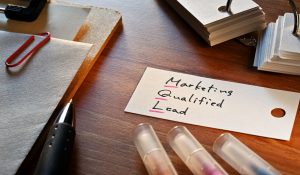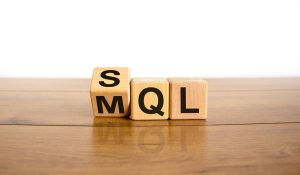
At the start of the fourth business quarter, strategic re-evaluations and growth strategies are usually initiated to stay ahead of the competition. Companies are aware that the behavior of B2B buyers is continuing to develop at a dizzying pace. So, recalibrating B2B lead generation strategies in this constantly altering environment is understandably challenging and mandatory for marketers.
Utilizing strategies like targeted outreach, content marketing, and data analysis, B2B lead generation services connect businesses with decision-makers, expanding clientele and streamlining sales by providing qualified leads.
Interesting B2B Lead Generation Statistics
- According to data from the Content Marketing Institute, 85% of B2B marketers rank lead generation as their top priority.
- 61% of marketers consider lead generation to be their greatest challenge. (Source: HubSpot)
- 80% of marketers believe B2B marketing automation increases lead generation (and conversions). (Source: APSIS)
- According to research by Sendoso, 80% of marketers believe marketing automation generates better leads. And 77% convert more leads than non-marketing automation users!
- If you can improve your volume or leads by 20% without sacrificing quality, your company’s income will grow by 20%.
If you were to mirror the above stats, what B2B lead generation strategy would you choose amongst the available dozen for your business?
Well, before you embark on the strategic aspect, we suggest you seek to clear and cover the basics first:
- Statistics
- Definition
- Importance of B2B Lead Generation
- Why is Data Important in B2B Lead Generation?
- What is B2B Leads?
- Types of B2B leads
- What Is the difference between an MQL Vs SQL?
- How To Generate B2B Leads?
- The B2B Lead Generation Process
- Who Conducts B2B Lead Generation?
- How is B2B Lead Generation Conducted?
- B2B Lead Generation Strategies
- Best B2B SaaS Lead Generation Strategies
- Tools for b2b lead generation
- B2B Lead Generation Benefits
- Channels
- Conclusion
What is B2B Lead Generation?
What is lead generation in B2B? In essence, B2B lead generation is the ‘organic’ customer acquisition. It includes various marketing strategies that increase the prospects’ exposure, awareness and interest in your product or service, within a specific target demographic.
The word resonates with the numerous approaches, channels and strategies employed for producing B2B leads, all designed to get high-converting customers into your sales funnel.

Lead generation is the initial stage in the buyer’s journey and is intended to move prospects through the sales funnel. Nevertheless, the forms of lead-generating tactics differ per product campaign and the choice of marketing platform.
The four factors influencing B2B lead generation are market, product, revenue model and acquisition channels. These factors will further impact how you frame your pitch and where you go to acquire customers.
Importance of B2B Lead Generation
Without a lead generation strategy, a business is a sitting duck. Its income and growth will depend on a target audience that may or may not be aware of its existence. No Lead Generation? There will be no “leads” for sales to pursue.
And why are leads so crucial? Because it is challenging to optimize growth and income without them. By implementing effective lead generation tactics, you can expand your business and increase the Customer Lifetime Value (CLV) of each existing lead and lower the Cost Per Acquisition (CPA) for your prospects.
B2B lead generation will allow you to build a predictable stream of sales leads, resulting in a more significant proportion of closed-won sales. This shows the importance of B2B lead generation.
Why is Data Important in B2B Lead Generation?
Without high-quality data, it is impossible to execute B2B lead generation.
With erroneous or missing contact information for B2B leads, it becomes difficult for the sales staff to make cold calls or send outbound emails without the prospects hanging up the call or the emails bouncing back!
If B2B demand-generation marketers have unclear data about their target accounts, it is far more difficult to design and push conversion-oriented content.
The importance of data in analytics and forecasting cannot be overstated. It offers the foundation for KPIs and standards for individuals and teams and; enables businesses to monitor production and outcomes.
What are B2B Leads?
Business-to-business (B2B) leads are recognized potential clients for an enterprise. They initiate the sales process with intent and are essential for maintaining a healthy sales funnel. Two types of B2B leads exist.
- Marketing – Qualified Leads (MQL)
- Sales – Qualified Leads (SQL)
The Types of B2B leads
B2B lead generation types are classified into two. Below is a brief on the same.
Marketing-Qualified Leads: MQLs, or marketing-qualified leads, are targeted leads regarded as highly likely to become paying customers. The qualification is dependent on the MQL’s participation in your company’s marketing activities.
Sales–Qualified Leads: SQLs are MQLs that have advanced through the sales funnel and are judged ready for engagement with your sales team. For a lead to be recognized as a SQL, they must have demonstrated an active intent to purchase your company’s goods or services.
What Is the difference between an MQL Vs. SQL?
Leads. Not everyone understands what to do with them once they get them. Thus, the inbound process comes into play!
In the contemporary digital consumer world, the inbound sales process places a heavy emphasis on MQLs and SQLs to assist marketing and sales teams in nurturing leads all the way through to a sale.
But what are they, how do they vary and how do you optimize the ROI of your inbound sales process by handling both MQLs and SQLs? Here’s a comparison!
| MQL | SQL |
|---|---|
| MQL is a contact that is sales-ready. | SQL is ready for direct sales follow-up. |
| A Marketing Qualified Lead (MQL) is a reasonably qualified lead who has downloaded a content offer or engaged with your marketing team but has not yet entered your sales funnel. | A Sales Qualified Lead (SQL) is a lead that has been qualified as a possible customer by your sales team. Your SQLs are in your sales funnel, and your team is actively working to close them. |
| A first-time visitor is a good example of a potential MQL. An MQL is a lead who is downloading and converting top-of-funnel content offers. | A SQL is a repeat visitor who has visited your website several times and is viewing important pages and downloading bottom-of-funnel content offerings. |
How To Generate B2B Leads?
We walked through the importance of B2B lead generation, and now the next aspect to consider is how to generate B2B leads.
You need to focus your attention on two B2B lead generation types: inbound and outbound marketing.

Inbound marketing activities aim to attract qualified leads and direct them to your website (or landing page), where they may submit a lead form.
The objective here is to attract, enlighten and engage your target audience to voluntarily provide their contact information, which will then be pulled into your CRM software.
Here are four instances of efficient B2B lead generation tactics with inbound marketing:
- Content marketing
- SEO
- Email marketing
- Webinars
While marketing teams typically oversee inbound marketing initiatives, marketing and sales are responsible for outbound operations.
Outbound marketing is when you actively distribute your company’s message to prospects you believe might make good customers, regardless of whether they have previously expressed interest in your product.
In order to develop forecasted leads in B2B sales, you must engage in outbound activities.
Here are seven tactics that will give you an advantage:
- Create a list of ideal prospects
- Send cold emails
- Roll out paid advertising
- Retarget
- Industry events
- Interact with leads via social media
- Ask current customers for referrals
The B2B Lead Generation Process
According to a DemandSage study, 61% of marketers believe B2B lead creation is a complex undertaking. As a professional in sales, you couldn’t agree more! So, what is a B2B lead generation process and how should one be constructed?
So, without much ado, let’s get started.
Learning how to acquire sales leads is only a portion of the process. An intensive lead-generating procedure is required to reach the core’s bottom line.
Ideal customer profile and buyer persona are two components of B2B lead generation for sales, without which it is impossible to develop the most effective lead generation methods.
While an ICP (Ideal Customer Profile) directs you toward the sorts of businesses you must target, a buyer persona helps you understand the individuals you must target.
Also Read: Top Lead Generation Trends to Implement in 2023
We know that lead generation refers to the method salespeople and marketing teams use to convert prospects into paying clients. However, what do these processes involve?
Step 1: Find B2B sales leads (Scrubbing the raw leads)
Most B2B lead-generating techniques start with buyer contact information. In-house, third-party “lead gen” companies and lead databases can provide contact information.
Step 2: Reaching out to leads (Inbound and Outbound)
With a list of high-quality leads, sales representatives reach out to prospects via cold outreach, social media, and responding to questions.
Step 3: Qualifying & prospecting for high-quality leads (Cold calling, Promotions)
During interactions with leads, sales representatives assess the likelihood of a sale.
They will do this by determining the stage at which leads are in the purchase process. These phases consist of:
- Research & Awareness
- Consideration
- Decision
Step 4: Close leads by making a sale (Quote Confirmation)
After many meetings with competing suppliers, the prospect chooses your company, and the transaction is closed. They will be forwarded to customer success for onboarding.
Who Conducts B2B Lead Generation?
Sales and marketing experts own B2B lead generation and play a critical role. For lead generation to be most successful, sales and marketing teams should be closely integrated; nevertheless, these experts may operate alone or in groups.
Below are a few points to be taken into consideration.
Sales: A B2B lead generation-focused sales force is divided into two groups:
- Sales Development Representatives (SDRs)
- Business Development Managers (BDMs)
Sales Development Representatives (SDRs): This group is responsible for sourcing and scoring leads and contacting them. Meeting scheduling falls under their roles and responsibilities.
Business Development Managers (BDMs): This team is accountable for performing demonstrations, completing transactions, and generating income for the company.
Below are a few benefits that this approach offers:
- It generates a robust pipeline for generating B2B leads.
- It enables each person to concentrate on a single responsibility.
- It creates a plan for professional development and advancement.
Marketing: There are two types of B2B lead generation marketers:
- Demand generation marketers
- Growth hackers
Their marketing strategies, however, differ.
Demand generation marketers: This team handles the B2B lead generation revenue cycle. They nurture leads from brand awareness to sure-shot customers and advocates.
Growth hackers: Growth Hackers prioritize rapid revenue development at a low cost. They work in early-stage start-ups and are experimental.
How is B2B Lead Generation Conducted?
The production of B2B leads is accomplished by a range of sales and marketing activities. Below are a few points to be considered.
Sales: The lead generation process in sales is referred to as B2B outbound. This method includes:
Cold calling: SDRs call B2B leads, describing their product or service and qualifying them for further engagement. Manual or automated cold calling is possible.
Outbound email: SDRs emailing B2B leads to start conversations. Automation platforms handle outbound emails.
Social selling: SDRs tracking B2B leads on social media and building relationships. LinkedIn dominates B2B social media promotions.
Sales cadences: The above methods form a cadence. Most SDRs use cadences to boost B2B lead response.
Marketing: How to generate leads and demand for your product or service? There are several tactics that marketers can leverage:
Growth Hacking: B2B marketers or growth hackers use unconventional methods to generate demand and develop their firms swiftly. Contests, freebies, and incentives are examples.
Content marketing: Marketers provide helpful material here. Blogs, videos, webinars, podcasts, and eBooks are pure content promotions.
Account-Based marketing (ABM): Marketers identify essential decision-makers in a company or account and design personalized marketing campaigns for them.
The objectives of these actions will differ based on the lead’s position inside the B2B marketing funnel. It could attract new leads to the company or encourage existing leads to make a purchase.
B2B Lead Generation Strategies
To produce more effective sales, your B2B lead generation techniques must be tailored to your industry, product, and buyer. Therefore, it is only possible to identify two or three lead creation tactics for an enterprise.
Below is a list of few B2B lead generation strategies:
- Automate your lead gen & email marketing campaigns
- Create referral campaigns to turn email leads into… more email leads
- Create an automated webinar strategy
- Add dynamic CTAs to your blog posts
- Build negative keyword lists in Google Ads
- Personalize your landing pages to match search intent
- Use LinkedIn Advertising to target big spenders
Your sales and marketing teams must be willing to experiment, learn and deploy innovative sales lead-generation techniques. This requires trying many techniques until one becomes effective.
B2B SaaS lead generation is the process of attracting prospective clients to your product or service to increase conversions. Ready to try something new? Test the following B2B lead generation strategies in 2023.
Best B2B SaaS Lead Generation Strategies
Take a quick look at B2B SaaS lead generation strategies to uplift your business. Below are a few points listed –
- Run A/B tests on key pages
- Use epic content campaigns to (continuously) generate B2B sales leads
- Earn your buyers’ trust with social proof
- Build a free tool to generate B2B sales leads
- Use Quora Q&As to generate more B2B sales leads
- Follow-up Bulk Emails with direct Email
- Encourage sharing on social media
- Benchmark your conversion rates
B2B Lead Generation Tools to Get More Leads
Don’t you think getting everything done manually is extremely draining? Manually prospecting for sales is time-consuming and diverts hours from other profitable sales operations.
A B2B Lead Generation tool automates and optimizes the prospecting procedure. It enables your marketing team to develop campaigns that generate more qualified leads.
With competent lead generation tools, sales representatives may automate routine activities and devote more time to close prospects. In addition, the lead creation software may increase your profitability and efficiency.
However, premium and free tools are distinguished. If you are just starting out or have a limited marketing budget, you may use these best free lead generation tools, like
Trustmary Solo: Review and testimonial software Trustmary helps you use social evidence. Trustmary Solo adds Google, Facebook, TripAdvisor, and Yelp reviews to your website for free.
Sumo: Sumo is a website with free tools to increase website traffic. Sumo simplifies email list signup, content sharing, and analytics optimization. The technology transfers lead instantly with email marketing and CRM applications.
Hotjar: Hotjar is a powerful website analytics and feedback tool that shows users what they think of your website, including the most common concerns and what they enjoy most.
Leadfeeder: Leadfeeder shows you which firms visit your website, even if they never contact you. Leadfeeder provides employee contact information.
And if you are willing to invest more in lead creation, consider the following paid lead generation tools:
Zendesk Sell: Zendesk Sell includes lead gen, prospecting, and enrichment features. These features free up your salespeople to hit their quotas.
Overloop: Overloop has everything you need for multi-channel outbound campaigns. For more on Overloop’s sales productivity and reporting tools, see their website.
Reply.io: The complete team engagement platform—Reply Chrome addon finds LinkedIn prospect emails in seconds, filling your pipeline.
Clickfunnels: It combines sales funnels with landing pages. The application lets you choose a sales funnel, add users to your email list, and collect money. The 14-day free trial is followed by USD 97/month subscriptions.
Benefits of B2B Lead Generation
At this point, you should realize that leads are crucial to the longevity of your company. However, what specific advantages does your company reap from lead generation? The following are some of the reasons why you should prioritize generating leads.
- Expand into new markets: Initially, you presumably targeted a certain set of individuals. But as your business grows, you should be open to more than specific industries. Lead generation helps you to learn about potential customers. You can develop into new markets with lead generation – that you would not otherwise have.
- Gather more customer reviews: Social proof through reviews or testimonials from previous customers effectively influences prospects to convert. These are not usually provided automatically. Therefore, it is beneficial to solicit consumer feedback and reviews. You may include this in your marketing materials, such as your website, emails, videos, social media postings, and infographics.
- Boost your revenue: When done correctly, lead generation may increase your brand’s capacity to reach specific prospects. This requires the appropriate language, offer, and content to pique the interest of these particular groups. This way you are likely to attract the interest of quality leads, making it easier for your sales teams to close the deal.
- Generate business opportunities: It is a prevalent misunderstanding that leads generation is exclusively used to locate prospects. However, it also brings business chances. Your non-competitive brands can collaborate with you to hold a webinar. And by collaborating, you can gain access to their audience. This connection is mutually beneficial and can generate more leads.
- Eliminate or Reduce Cold Calling (and Emailing): Why continue to use ineffective outbound strategies, such as cold calling and emailing, when you are inundated with high-quality leads? This will save up a substantial amount of your salespeople’s important time. This will allow them to focus on completing more transactions with prospects who will buy your goods.
The Gold Rush: The Best B2B Lead Generation Channels Out There!
In 2023, B2B marketing will fully embrace digital disruptions. Join this race? To get ahead of the competitive curve, your business must adopt a mix of B2B lead generation channels that should provide you with a good starting point for your foolproof lead generation strategy.
Here you go with the details of the said channels –
- Content marketing: B2B content marketing will continue in 2023. Content may reach top-of-funnel consumers and cultivate prospects. Content marketing dominates inbound marketing Counsel. Promote product tutorials, product assessments, expert interviews, customer testimonials, and case studies via social media and email. This will help build credibility and generate leads from your present audience.
- SEO: SEO brings organic search engine traffic to your website. SEO is vital for staying top-of-mind with consumers since they use search engines throughout the purchasing cycle.
Starting with assessing search intent and choosing keywords for each phase of the buying cycle is easy. SEO will help your pipeline if you have search-optimized content for each lead kind.
- Influencer marketing: Influencers are the most reliable users of social media networks. Influencers, like NASCAR drivers, utilize their clout to acquire sponsorships from related firms. Influencer marketing lends your firm reputation and authority among a targeted audience. If you work with the right influencer, you may create profitable customer relationships.
- Social media: Paid social media advertisements are a realistic outbound option if you need help growing a following organically. By asking for feedback on your latest social postings, listening to their issues, and letting them know what to expect from you, you can demonstrate great customer service. It helps to boost brand equity this way!
Conclusion
Are you cognizant that B2B lead generation is the art of campaigning that requires constant evolution? What is currently working like magic may alter radically in the following days. Consequently, it is essential to monitor the shifting preferences of your consumer base.
This not only broadens clientele but also streamlines sales by delivering quality leads. In essence, B2B lead generation companies are vital for driving business growth and revenue in the B2B sector.
Contact us now if you would like to learn how Binary Demand can change your B2B lead generation approach with high-quality, globally compliant data.
FAQs
Q. Where does lead generation fit within your B2B sales funnel?
A. Lead Generation is at the top portion of your sales funnel: To capture the interest of your target audience. You can offer your prospects a lead magnet that is so valuable that they cannot resist it. Get them to visit the landing page and provide their contact information!
Q. What technology can help with B2B lead generation?
A. Top 4 technology solutions that can significantly improve your B2B lead generation performance and save you time and resources are:
- Search Engine Optimization (SEO)
- Chatbots
- Web scraping
- The ROI Calculator
Q. How B2B Chatbots are increasing conversions and lead generation?
A. Below are the best practices for using chatbots to increase conversion and lead generation:
- Set up chat for real-time engagement
- Respond to leads with lightning speed
- Personalize your chat messages
- Provide your best prospects with the fast lane to sales
Q. How can chatbots help in B2B lead generation?
A. Lead generation chatbots may help you understand your target demographic and find new clients by collecting data. Replacing static forms with proactive bots engages and builds relationships with potential clients.
Q. Which B2B lead generation methods work best?
A. HubSpot lists SEO (14%), email marketing (13%), and social media (12%) as the three best lead sources for B2B firms.











